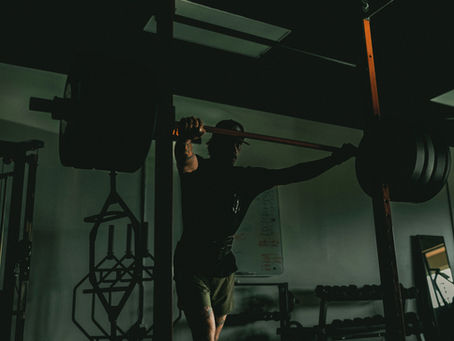top of page
Search


Why “Less Is More”
For masters sprinters, the winning formula isn’t more training. It’s better training. Sprinting in your 30s, 40s, and beyond presents a unique challenge. You’ve got the competitive drive, the experience, and often the discipline you lacked when you were younger — but your body doesn’t bounce back quite the same way. The trick isn’t trying to train like you used to. It’s learning to train smarter.

Coach Dave
6 days ago3 min read


The Keys to Stronger Butterfly Performance
The butterfly stroke is one of swimming’s most physically demanding disciplines, requiring power, technique, and anaerobic endurance. While mastering the stroke in the water is crucial, research shows that targeted strength training is a game-changer for performance.

Coach Dave
Oct 142 min read


Every Run Counts
Success is about making sure that everything in your training—your runs, your strength work, your mobility, your recovery—serves a clear and specific purpose.

Coach Dave
Oct 72 min read


The Ebbs and Flows of Success
Progress doesn’t follow a straight line — it comes in waves. There are good weeks, average weeks, and some that make you wonder if you’ve gone backwards altogether.

Coach Dave
Sep 302 min read


Starting Small: Low-Level Plyometrics for Masters Athletes
In our last blog, Never Too Old To Jump, we explored why Masters athletes should keep jumping as part of their training. The next question is how. The good news? You don’t need to start with box jumps or advanced depth jumps. In fact, low-level plyometrics are often the best place to begin. They give you all the benefits—improved power, tendon health, and efficiency—without excessive stress on the joints.

Coach Dave
Sep 172 min read


Never Too Old to Jump
One of the first things many athletes over 30 let go of in training is jumping. It’s often seen as too risky, too hard on the joints, or simply unnecessary once you’ve moved beyond your twenties. But here’s the reality: you’re never too old to jump. In fact, plyometrics and jump variations may be some of the most valuable tools in your training arsenal as a Masters athlete.

Coach Dave
Sep 172 min read


Goal Setting That Actually Works for Athletes
When one season ends, athletes naturally start looking to the next. The temptation is to jump straight into training, but without clear goals, training lacks direction. Goal setting isn’t just about picking an ambitious target race or competition—it’s about creating a framework that makes daily training purposeful and sustainable. Done well, goals act as your roadmap. Done poorly, they become a source of frustration and burnout.

Coach Dave
Sep 93 min read


Stop Drowning In Volume
For most Masters athletes, piling on volume doesn’t make you fitter or faster. It just makes you tired.

Coach Dave
Sep 32 min read


The Power of Not Moving – An Insight into Isometrics
When people think about training, they usually picture movement—lifting, sprinting, swimming, or jumping. Yet some of the most effective training methods involve not moving at all. Isometric training, often overlooked, is a powerful way to build strength, stability, and resilience.

Coach Dave
Aug 272 min read


Faster in the Pool—Without Adding Extra Laps
For many masters swimmers, the first response to a plateau is simple: swim more. Another lap, another set, another long session in the pool. But just as in running, piling on extra distance isn’t always the answer. In fact, the fastest path to becoming a stronger, more efficient swimmer often lies outside the pool

Coach Dave
Aug 192 min read


Enhancing Athletic Performance—The Legal Way
In competitive sport, the search for a performance edge is relentless. The most effective and sustainable gains come from applying proven, lawful methods with discipline and precision.

Coach Dave
Aug 122 min read


Is Your Training Program Actually Working?
If you’re an athlete over 30, consistent training is non-negotiable—but consistency alone doesn’t guarantee results. Many athletes follow demanding programs that feel effective but fail to deliver measurable progress. The problem? A lack of structure, feedback, and long-term planning.

Coach Dave
Aug 52 min read


Eliminate Pre-Competition Doubts with Properly Structured Training
Doubt creeps in when there are gaps—gaps in your preparation, in your recovery, in your belief that you've done enough. But when your training is structured, specific, and purposeful, those gaps close fast. The fog of “what ifs” lifts, and what’s left is clarity, confidence, and calm.

Coach Dave
Jul 292 min read


Your Competition Has a Strength & Conditioning Coach – Do You?
Is your training actually giving you a competitive edge? Because your rivals—the ones who are edging you out at the finish line, outlasting you on the field, or consistently hitting personal bests—they’re not guessing.

Coach Dave
Jul 222 min read


Why You’re Still Slow: 5 Speed Killers Holding You Back
Speed is a ruthless teacher. You either get faster or get left behind—and often, it’s not for lack of hard work, but because of avoidable mistakes that sabotage your progress. Here are five common mistakes that mean you're running with the handbrake on.

Coach Dave
Jul 152 min read


How Perfect Do Athletes Need to Be When Olympic Lifting?
Olympic lifts—the snatch and the clean & jerk—have long been embedded in athletic development programs for their capacity to develop high...

Coach Dave
Jul 82 min read


How Neural Fatigue Can Make or Break Your Sprint Performance
You train hard. You fuel well. But sometimes, your sprints still feel flat. The reason might not be your muscles—it could be your nervous system. Neural fatigue, specifically central nervous system (CNS) fatigue, directly affects how powerfully and precisely your body moves. In this article, we break down what neural fatigue really is, how to spot it, and how to train smarter around it so your sprint sessions stay sharp, fast, and effective.

Coach Dave
Jun 302 min read


Climb to Perform: Why Stair Workouts Are a Smart Move for Athletes Over 30
Stair runs and jumps combine strength, speed, and conditioning in one efficient package. They challenge the legs, lungs, and mind. For Masters athletes looking to maintain power, protect joints, and stay explosive, stairs are a smart addition to the program.

Coach Dave
Jun 242 min read


Strength Training for the Female Athlete Over 35: What the Science Says
The athletic journey doesn’t end at 35—but it does change. For female athletes, this shift can feel frustrating: longer recovery, slower...

Coach Dave
Jun 103 min read


From Sedentary to Strong After 30: The Comeback Blueprint
If you’re ready to rebuild strength, fitness, and confidence after time away from training, this is your blueprint.

Coach Dave
Jun 32 min read
bottom of page
